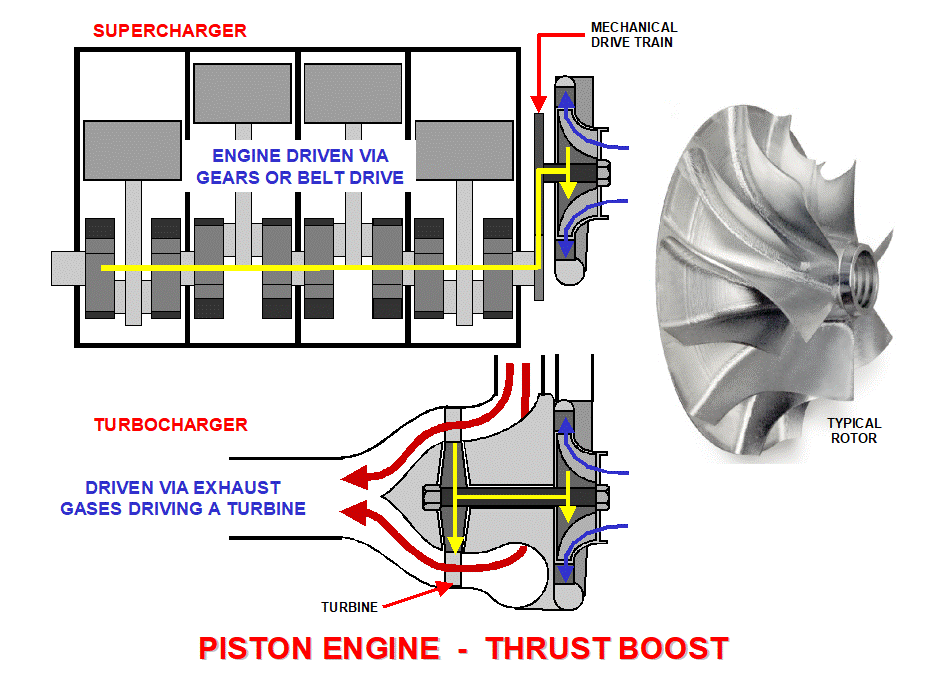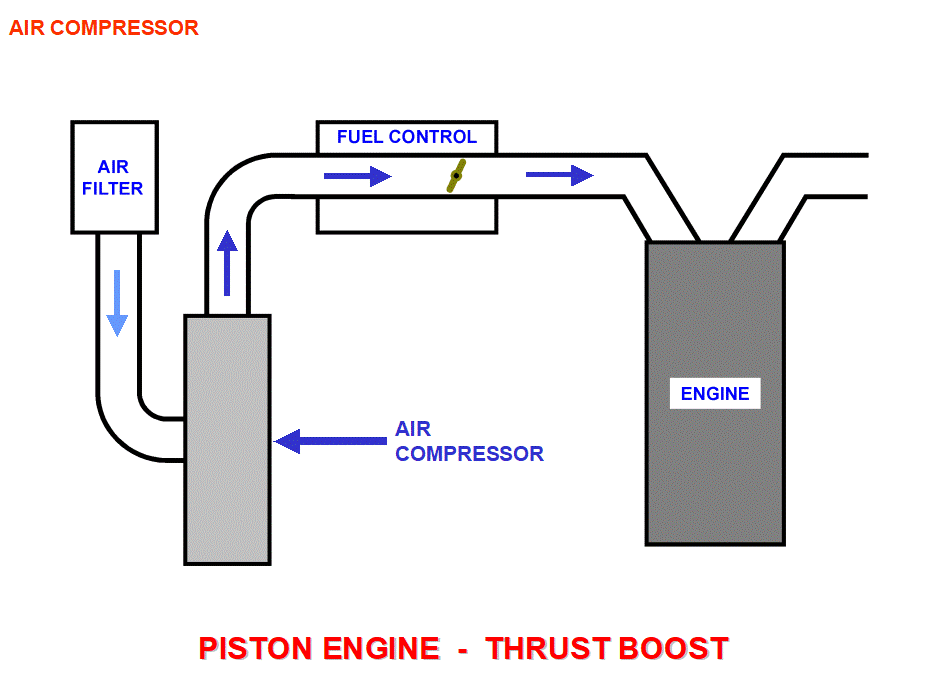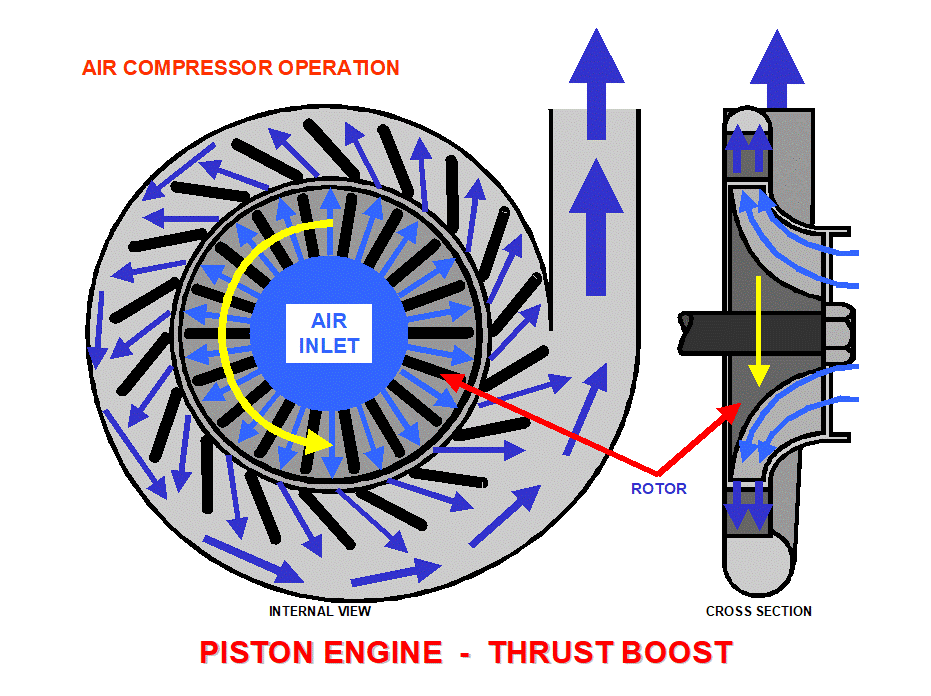THRUST AUGMENTATION – Booster Types
General
Increasing engine power cannot be achieved just by adding more fuel; this would simply change the air to fuel ratio and result in unburnt fuel being wasted and passing through the exhaust. More power means adding more air and fuel.
Boosters are a type of forced air induction system; they work by compressing the air flowing into the engine. The advantage of this is that more air (approximately 50%) is fed into the engine, and more air means that more fuel can be added.
More air and fuel means more power is developed by the engine, this can significantly improve the power-to-weight ratio for the engine
There are two types of booster: -
Supercharging and Turbocharging
Supercharging
This is an air compressor driven by the engine mechanically via a gear train or belt drive. Superchargers can take approximately 20% of the engine power to drive them, but can increase overall engine power up to 50% or more, giving a net gain of 30%+ power.
Turbocharging
This is a similar air compressor driven by the engine exhaust gases passing through a turbine. Turbo’s take very little power from the engine to drive them, therefore the net gain in power is relatively greater.
Operating Differences
Turbochargers can suffer from what is known as ‘turbo-lag’, this is where boost power is required but because of the low engine rpm, there is insufficient energy in the exhaust to power up the turbine and therefore the air compressor.
This can be overcome by fitting smaller turbos that come into operation at earlier engine rpm, but these can then suffer excessive rotational speeds at higher throttle settings. These smaller turbos are protected from overspeeding by a ‘waste-gate’; this opens at a set maximum boost pressure and allows some exhaust gases to bypass the turbine, thereby restricting their maximum rpm.
Superchargers do not suffer lag but can be ineffective at low rpm’s. Different types of ‘blowers’ can be fitted which are more effective at lower rpm’s; these can be viewed via the internet.


THRUST AUGMENTATION – System
Booster location
They are fitted in the intake system of the engine between the air filter and the fuel controller.
The supercharger is normally fitted on the engine at the free end of the crankcase. In the case of the Merlin, the front end of the crankshaft drove the propeller, so the supercharger was fitted to the rear end of the engine.
Turbo chargers can be fitted anywhere, but for convenience, they are usually fitted on the exhaust side of the engine.
Either can be fitted as an aftermarket upgrade, all that is required is a change to the inlet and, for the turbo, exhaust pipe work.
Intercooling (not shown below)
Compressing air increases its temperature, this can increase the risk of premature detonation, i.e. before the spark plug ignites the mixture. Reducing the temperature can improve the efficiency of the boost.
Intercoolers are fitted in the induction system between the booster and fuel controller and work exactly the same as engine cooling radiators, both use ambient, or slipstream air as the cooling medium.
Intercoolers have air both sides, with the ambient air cooling the compressed air from the booster.
Water or Water/Alcohol Injection
Fluid injection systems were introduced primarily to cool the boosted air to the engine, thereby reducing detonation, also termed pre-ignition, knocking, or pinging. Pre-ignition can cause severe damage to the engine such as splitting and holing pistons.
Adding fluid, either at the inlet to the intercooler, beginning of the inlet manifold or just before the inlet valve, reduces the heat of the inlet air to the engine.
This protects against detonation and allows more fuel to be added. The extra fuel can be either the alcohol additive or an increase in the normal fuel.
Fluid injection systems have disadvantages which outweigh the advantages, except for specific applications, such as military aircraft or racing aircraft. WWII fighters often incorporated the system to enable fast take off and climb to intercept enemy bombers.

THRUST AUGMENTATION – Booster Operation
Operation
Irrespective of the way in which the compressor is driven, the compressor works by using centrifugal force.
This spins the air between the rotor vanes, forcing it from the centre out to the rim, where the exit area is smaller than the inlet area, then pushes the air through the static fins or stator vanes, arranged around the rim of the rotor.
Half of the pressure rise across the whole of the booster is achieved by the rotor, the other half being ahcieved in the stator vanes.
This compressed air is then piped to the fuel controller (via and intercooler if fitted), and then to the engine.
General
Engine boosting helps at high altitudes, where the air is less dense. Normal engines will experience reduced power at high altitudes because for each stroke of the piston, the engine will get a smaller mass of air.
Boosting and engines power can restore engine power due to the effects of altitude. This makes sense when you consider that airplanes spend most of their time at high altitudes, where significantly less oxygen is available for combustion. With the introduction of superchargers, airplanes were able to fly higher without losing engine performance
One of the most famous engines from WWII featured a supercharger, the MERLIN, fitted to the Spitfire, Hurricane, Lancaster, and Mustang (made by USA company Packard under licence), plus numerous other aircraft types, including a Spanish built variant of the Bf109!
It was the Merlin’s supercharger technology that was developed into the Rolls-Royce Dart Turboprop engine.

Source: http://www.1982.org.uk/index.php/the-squadron/resources-download/category/20-piston-engine-propulsion?download=127:piston-engine-propulsion-chapter-8-notes
Web site to visit: http://www.1982.org.uk
Author of the text: indicated on the source document of the above text
If you are the author of the text above and you not agree to share your knowledge for teaching, research, scholarship (for fair use as indicated in the United States copyrigh low) please send us an e-mail and we will remove your text quickly. Fair use is a limitation and exception to the exclusive right granted by copyright law to the author of a creative work. In United States copyright law, fair use is a doctrine that permits limited use of copyrighted material without acquiring permission from the rights holders. Examples of fair use include commentary, search engines, criticism, news reporting, research, teaching, library archiving and scholarship. It provides for the legal, unlicensed citation or incorporation of copyrighted material in another author's work under a four-factor balancing test. (source: http://en.wikipedia.org/wiki/Fair_use)
The information of medicine and health contained in the site are of a general nature and purpose which is purely informative and for this reason may not replace in any case, the council of a doctor or a qualified entity legally to the profession.
The texts are the property of their respective authors and we thank them for giving us the opportunity to share for free to students, teachers and users of the Web their texts will used only for illustrative educational and scientific purposes only.
All the information in our site are given for nonprofit educational purposes